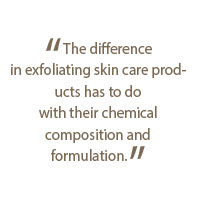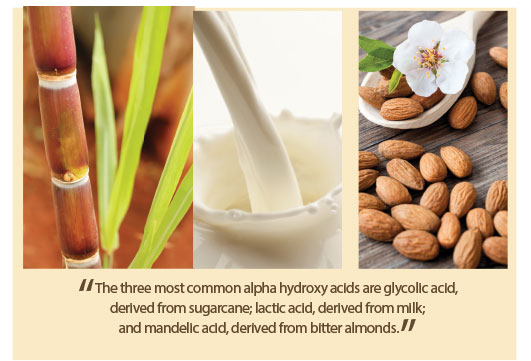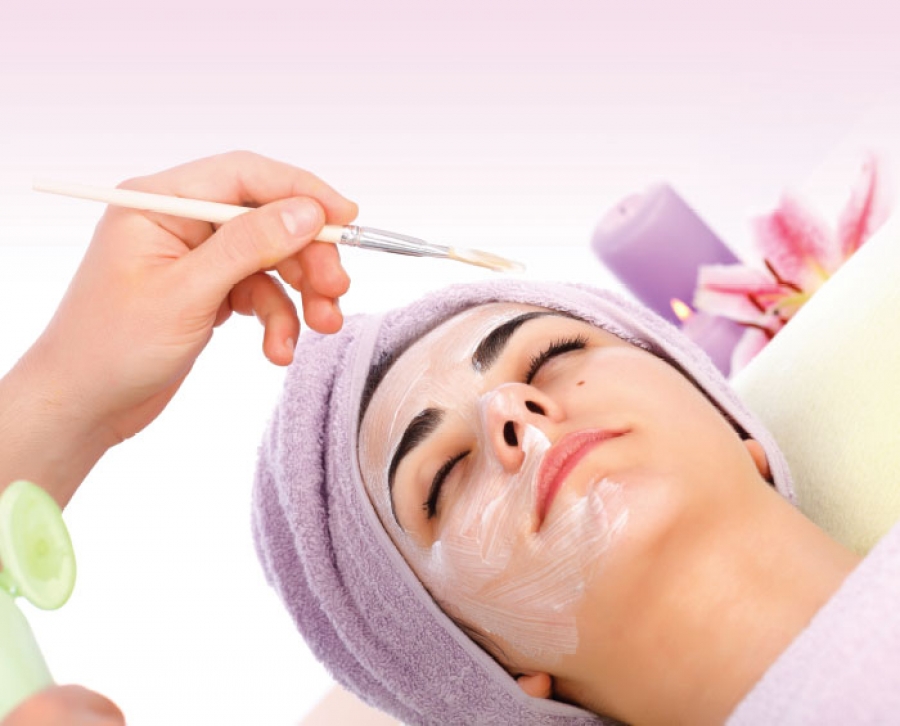 The use of exfoliation was advanced in 1881 when noted German dermatologist, Paul Gerson Unna, combined resorcinol, salicylic acid, phenol, and trichloroacetic acid in an innovative chemical peel that he used to treat patients in his private clinic. In the 1950s, Dr. Max Jessner modified Unna's peel by replacing the phenol, which was known to carry a risk of cardiotoxicity, and the trichloroacetic acid with lactic acid. The Jessner peel is still used today.
The use of exfoliation was advanced in 1881 when noted German dermatologist, Paul Gerson Unna, combined resorcinol, salicylic acid, phenol, and trichloroacetic acid in an innovative chemical peel that he used to treat patients in his private clinic. In the 1950s, Dr. Max Jessner modified Unna's peel by replacing the phenol, which was known to carry a risk of cardiotoxicity, and the trichloroacetic acid with lactic acid. The Jessner peel is still used today.
During World War I, the use of antibacterial phenol bandages for wound care led to another revelation in the practice of exfoliation. Dr. LaGasse, a French physician, noticed that the phenol bandages used to treat facial burns and scarring not only promoted a healing effect, but also a significant cosmetic improvement. His techniques became the basis of the popular cosmetic peel created in 1960 by physicians T.J. Baker and H.L. Gordon.
Today, there are still organic exfoliants, but modern technology has been added to the process with machines and lasers. Mechanical exfoliation is using an instrument; ground-up, organic elements in facial scrubs; and abrasive pads to create friction on the surface of the skin. The most effective form of exfoliation is chemical. Chemical exfoliation uses an array of chemicals, such as alpha hydroxy acids, beta hydroxy acids, retinols, enzymes, trichloroacetic acid, and resorcinol. It is important to clarify that chemical exfoliation is not a procedure that is strictly limited to a doctor or skin care professional's office. Chemical exfoliants can and should be used at home on a regular basis.
EXFOLIATION BASICS
Exfoliation primarily affects the top layer of the epidermis: the stratum corneum. On a daily basis, millions of dead cells rub off, ultimately revealing a new stratum corneum about every 30 days. The stratum corneum acts as a protective shield for the deeper cells of the body. Without it, the body would have no protection from environmental dangers like sun, pollution, or bacteria. The stratum corneum also guards the body from transepidermal water loss by creating a barrier that traps and holds moisture in the skin.
Keratinocytes, the predominant cell type in the epidermis, are constantly being synthesized in the stratum basale and pushed to the surface of the skin as they mature. The function of keratinocytes is to produce the fibrous protein keratin, which gives the epidermis its protective qualities. They are tightly bound to one another by desmosomes made up of lipids, ceramides, cholesterol, and fatty acids, which form a glue-like matrix. As epidermal stem cells differentiate, they move upward from their basic state in the stratum basale by the generation of new cells under them. During this process they produce keratin, which becomes the main content of the cell. Eventually, these keratin-filled cells, called horny cells, reach and form the upper part of the epidermis, the stratum corneum.
Chemical or mechanical exfoliation increases keratinocyte proliferation by weakening the intercellular glue that binds the dead cells together, allowing these cells to shed off, which clears the top layers of the stratum corneum of dead skin cells, debris, and impactions.
This accelerated keratinization increases the collagen layer in the stratum basale while thinning the stratum corneum. As a result, the skin appears brighter because it reflects more light; it is more even in color and has fewer fine lines.
There are many exfoliating products that accomplish this process in different ways, but the result is the same: glowing, brighter, healthier skin. Exfoliating on a regular basis has many benefits.
ADVANTAGES AND BENEFITS OF EXFOLIATION
Acne improves more rapidly when using exfoliants. Most of the body's sebaceous glands are located on the face, back, and chest. Acne is most commonly found in these areas. It is caused by epidermal hyperproliferation, a process that occurs when the follicle becomes clogged by the epidermal cells lining it, which leads to the formation of open and closed comedones. Clinical experience has proven that the more the skin is exfoliated, the faster the acne clears up; faster clearing leads to less scarring.
Exfoliating the dead surface cells of the skin allows for better absorption and optimization of topical skin care products. Prescription medications, such as topical Erythromycin and Clindamycin, are more effective when used in combination with an exfoliating topical, such as a retinoid or an alpha hydroxy acid.
Photodamaged, wrinkled skin improves dramatically with the regular use of exfoliants. Skin becomes firmer and smoother, and there is an increased thickening of the skin at the deeper layers.
Extremely dry skin becomes less of a challenge when it is treated with exfoliants. Moisturizers are more effective and therapeutic on exfoliated, dry skin. There is less transepidermal water loss. Mild exfoliants will not increase the amount of transepidermal water loss or change the barrier structure of the skin.
UNDERSTANDING THE DIFFERENT EXFOLIANTS
The difference in exfoliating skin care products has to do with their chemical composition and formulation. Most skin care professionals use benzoyl peroxide, alpha hydroxy acids, beta hydroxy acids, trichloroacetic acid, combinations of resorcinol, Jessners, or retinoid products formulated in a cream or a gel. The pH or the percentage of the exfoliating product determines whether it can be used at home, by the skin care professional, or if it is limited to the doctor's office. Regulations differ by state, and there are at least 12 states that do not have standards for the aesthetician to follow.
Benzoyl Peroxide
While most products work only on the surface of the stratum corneum, benzoyl peroxide is exceptional because it penetrates the pore, where it releases free radical oxygen. This antibacterial action kills the P.acnes that support and catalyze the acne process. This action also unplugs the pore and pushes the comedones to the surface, making extraction simpler.
Benzoyl peroxide is available in soaps, lotions, creams, gels, and pads. Furthermore, it comes in washes and scrubs with percentages of two to three percent and a topical gel at 10 percent. It is often paired with a topical vitamin A for maximum results. However, it is imperative to instruct clients not to apply benzoyl peroxide on top of a retinoid product as it will deactivate the vitamin A product.
Alpha and Beta Hydroxy Acids
When analyzing the different approaches to chemical exfoliation, there is no doubt that alpha hydroxy acids are on the top of the list. Alpha hydroxyl acids are organic compounds that contain carbon. These carbon chains are typically derived from natural food products, water soluble, and, depending on their length, penetrate the skin at various rates. When applied to the surface of the skin, they weaken the glue-like lipid structure to rid the stratum corneum of layers of dead skin cells. Alpha hydroxy acids can be found in different concentrations and pH levels in all types of skin and hair care products, washes, tonics, serums, and chemical peels.
The three most common alpha hydroxy acids are glycolic acid, derived from sugarcane; lactic acid, derived from milk; and mandelic acid, derived from
bitter almonds.
Glycolic acid is the smallest alpha hydroxy acid molecule with a two-carbon chain. Being the shortest chain, it is the fastest acting of the three. It penetrates the skin very quickly, making it a highly efficient, yet irritating alpha hydroxy acid to sensitive skin. It can be used in concentrations ranging from 20 to 70 percent in a professional setting and up to 10 percent in home use products. The percentage of the acid, along with the pH of the product, contributes to the potency of the peel and the cellular turnover during the exfoliation.
 A gentler alpha hydroxy acid, lactic acid, is formed by a three-carbon chain and has a penetration slower than that of glycolic. Lactic acid is used to exfoliate and peel more sensitive skin. Levels of peels depend on the concentration of the acids, which can be used up to 85 percent in a professional setting and up to 15 percent for regular home use.
A gentler alpha hydroxy acid, lactic acid, is formed by a three-carbon chain and has a penetration slower than that of glycolic. Lactic acid is used to exfoliate and peel more sensitive skin. Levels of peels depend on the concentration of the acids, which can be used up to 85 percent in a professional setting and up to 15 percent for regular home use.
Mandelic acid is a very interesting and powerful alpha hydroxy acid. Although mandelic has an eight-carbon chain, making it slow to penetrate, it still works wonders on the skin. This bitter almond derivative has antimicrobial, skin lightening, and gentle exfoliating properties. Because of its antibacterial properties, mandelic acid was originally used in hospitals to treat urinary tract infections.
The slightly larger carbon chain allows mandelic acid to penetrate the skin at a slower rate, thus causing less irritation to the skin and preventing post-hypopigmentation and -hyperpigmentation after use. Mandelic acid is excellent for evening out skin tone as it inhibits melanin production and, through gentle exfoliation, removes discoloration of the skin. Being one of the safest alpha hydroxy acids to use on a broad spectrum of skin types, mandelic acid is widely used at home and in professional settings. Chemical peels contain up to 30 percent mandelic acid with a pH of about 1 to 2, while homecare products can range from one to 15 percent with a pH from 3 to 4. In a study conducted over a three-year period, Dr. Mark Taylor concluded that "mandelic acid products, used alone or in tandem with antioxidant vitamins, have multiple beneficial effects as a skin treatment—including antibacterial effects and improvement on photo-aged skin, acne, abnormal pigmentation, and skin texture."1 Using mandelic acid before and after a strong chemical acid peel will minimize the chances of hyperpigmentation. Mandelic acid also improves the condition of photodamaged skin and calms non-cystic inflammatory acne.
When evaluating the efficacy of an 85 percent lactic acid versus a 70 percent glycolic acid peel on fine wrinkles, one study concluded that, with lactic acid, there was significant improvement after the second peel, whereas, with glycolic acid, there was significant improvement observed within the first peel.2
The most common beta hydroxy acid is salicylic acid, which is derived from salicin, a bitter compound extracted from the inner bark of the willow tree. It is lipophilic and has no humectant properties. Anti-inflammatory, antibacterial, and capable of deeply penetrating the follicle to force out acne impactions, salicylic acid is a common ingredient in acne treatments. Salicylic acid, however, is not a good choice for dark skin due to its tendency to cause hypopigmentation with repeated use.
 Retinoids
Retinoids
Vitamin A reduces the process of hyperkeratinization, which is an abnormal clumping up of the cells in the hair follicle, leading to impactions. This reversal of comedogenesis can clear up acne and, with continued use, arrest the acne process. Severely photodamaged skin has an abnormal thickening of the stratum corneum. Applying a topical vitamin A normalizes the stratum corneum. This reduction of keratin cells in the stratum corneum gives the skin a rosy, healthy glow and reduces the appearance of fine lines.
The thinning of the stratum corneum also enhances the ability of topical products to better react with the skin.
Vitamin A is part of the body's natural repair system. The body stores vitamin A, or retinol, for use in the production of new collagen. As the body ages, its ability to produce and store vitamin A is diminished, making topical application all the more necessary.
All topical vitamin A products work in much the same manner, but effectiveness varies, dependent on the molecular size and length of the carbon chain. The most effective and fastest acting vitamin A product is transretinoic acid or tretinoin known as the prescription Retin-A, which is now prescribed in a strength of .01 percent and .05 percent.
In 1969, Albert Kligman, James E. Fulton, and Gerd Plewig, medical doctors at the University of Pennsylvania, researched and developed the retinoic acid concentrations for the treatment of acne. Researchers at the University of Michigan (including John Voorhees, M.D.) subsequently noted that users in the study group also experienced a softer skin texture and fewer wrinkles. This discovery led to Retin-A being approved by the FDA for use in the treatment of photodamaged skin. Because of its propensity for irritation, this Retin-A acid formulation is available by prescription only.
Gentler all-trans retinols, vitamin A palmitate and vitamin A propionate, are commonly found in over-the-counter products. The skin has the natural ability to transform all tretinoin into retinoic acid (Retin-A), but because the skin acts as a guard gate for the body, it is very partial about restricting large molecules with long-carbon chains from passing through the stratum corneum.
Vitamin A palmitate was commonly found for many years in over-the-counter cosmetic products and heavily marketed as the cousin of Retin-A. It has a very large molecule and a 36-carbon chain that oxidizes quite slowly. Poorly converted by the skin into retinoic acid, it is easily degraded by oxygen and sunlight. In strengths of less than 5 percent, it has no effect on the skin.
In 1990, James E. Fulton researched and patented the retinoid analog, vitamin A propionate. It contains a 23-carbon chain and, with use over a longer period, this short-chain retinol gives similar results to Retin-A without the excessive redness and irritation. Vitamin A propionate accelerates the body's natural cell renewal cycle from 30 days to between 10 to 14 days. With its shorter chain, the results are far superior to vitamin A palmitate. In a strength of 1 percent, it is about as effective as a .01 percent retinoic acid.
Peels
Dating back to ancient Egyptian and Greek civilizations, the chemical peel is the oldest and strongest of the exfoliating processes. Although peels are mostly used on the face, they can be beneficial when used on the outer hands, neck, or legs when treating acne, photodamage, fine lines, wrinkles, uneven texture, and melasma.
Comprised of a single acid solution or a combination of acids, the peel formulation is applied to the skin by an aesthetician or physician.
It is recommended that the skin be pre-treated with homecare products prior to applying a peel. The length of time of pre-treating the skin depends on the Fitzpatrick number of the skin. Peels are generally more successful with skin conditions such as melasma if the skin is pre-treated with melanocyte-suppressing products for a period of time prior to the peel. There is a downtime with deep chemical peels as the skin may exfoliate for five or six days following the peel.
Chemical peels significantly improve skin texture by removing the damaged outer layers of the stratum corneum. However, there are conditions that a chemical peel will not correct; this reality should be explained to the client. Chemical peels will not remove deep acne scars or ice pick scars. They do not change pore size or remove broken capillaries, and they will not remove deep lines and wrinkles or tighten sagging skin.
Acne patients may experience a flare, but the flares will be easier to extract four or five days after a peel. It will bring blackheads to the surface and help to open closed comedones. Giving a series of peels four weeks apart, over a six month period of time, will give the greatest improvement. As part of client education, explain this timing to them prior to having the first peel so that there is no misunderstanding.
WORDS TO THE WISE
Peels can be tricky. If they are not applied correctly, they can cause serious damage to the skin and, in extreme cases, can be deadly.
Phenol, because of its cardiac toxicity, should only be used in a physician's office and a cardiac monitor must be used with any percentage over two percent. The Penny Rule prohibits a skin care specialist from using a phenol solution above two percent. This law was enacted after World War II when the use of high concentrations of phenol resulted in multiple deaths.
Resorcinol is another chemical that should be used with care. Almost identical to phenol structurally and chemically, resorcinol is extracted from petroleum. High concentrations of this chemical can be toxic to the liver and may cause nausea or dizziness if too many areas are peeled at once.
The medium-depth Jessner's peel is formulated with three chemicals, each at 14 percent: lactic acid, salicylic acid, and resorcinol. The resorcinol in this peel can be replaced with trichloroacetic acid.
BOTTOM LINE
Exfoliation can have different meanings to the physician, skin care professional, and client. The how, what, and why of regular exfoliation are things every skin care professional should discuss with their clients. Educating clients about the benefits and concerns of exfoliating products they use is important as they will be more consistent in using their products properly on a regular basis.
Throughout history, the methods of exfoliation have advanced, but the process is fundamentally unchanged. Exfoliation remains, perhaps, the single most important tool for obtaining and keeping beautiful skin. In whatever form, from light micro-exfoliation to a heavy chemical peel, there is simply no better way to improve tone and texture and rejuvenate the skin.
References
1 Taylor, M. (1999). Summary of Mandelic Acid for the Improvement of Skin Conditions. Cosmetic Dermatology.
2 Prestes, P. S., Oliveira, M. M., & Leonardi, G. R. (2013). Randomized clinical efficacy of superficial peeling with 85% lactic acid versus 70% glycolic acid. Anais Brasileiros de Dermatology, 88(6), 900-905.
 Sara Fulton is the co-founder and president of Vivant Skin Care. She has more than forty years of research, formulating, manufacturing and clinical experience with skin care.
Sara Fulton is the co-founder and president of Vivant Skin Care. She has more than forty years of research, formulating, manufacturing and clinical experience with skin care.
 Vanessa Campa is a senior research chemist with over six years of experience developing skin and hair care products. She was mentored by Dr. James E. Fulton in his medical practice and the Vivant Skin Care laboratory, where they worked together.
Vanessa Campa is a senior research chemist with over six years of experience developing skin and hair care products. She was mentored by Dr. James E. Fulton in his medical practice and the Vivant Skin Care laboratory, where they worked together.
